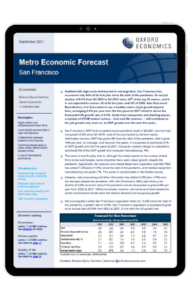US | Metro Economic Forecast: San Francisco

Saddled with high costs that has led to out-migration, San Francisco has recovered only 40% of its lost jobs since the start of the pandemic. Its net job decline of 8.3% from Q1 2020 to Q2 2021 ranks 46th of the top 50 metros, and it is not expected to recover all of its lost jobs until Q3 of 2022, later than most. Nevertheless, it is forecasted to see a healthy return of job growth beyond then, averaging 0.8% per year over the five years to 2027 which is above the forecasted US growth rate of 0.5%. Aside from restaurants and drinking places, a number of STEM-related sectors – tech and life sciences — will contribute to the job growth and, more so, to GDP growth over the next five years.
What you will learn:
- San Francisco’s GDP level exceeded its pre-pandemic peak in Q2 2021 and has had net growth of 2% since Q4 2019, most of this was fueled by the tech sector.
- The same is true for jobs; that is, although the media reports on the exodus of tech firms to low-cost locales, some industries have seen robust growth, despite the pandemic.
- Likewise, data processing and other information has added 5,300 jobs (+7%) over the last year despite the pandemic.
Tags:
Related Services

Post
Nowcast shows wage growth slowing sharply
Our sentiment data, developed with Penta, suggests that UK private sector wage growth slowed sharply in March and early-April. If official data mirrors our sentiment indicator, it should keep the Monetary Policy Committee on track to cut interest rates in the summer.
Find Out More
Post
The euro and depreciation – shake, shake it off
Our new forecast assumes a slower euro appreciation against the dollar over the coming years than we previously anticipated. Relative productivity, terms of trade, and the current account will likely be less supportive of the euro than we thought. In addition, a stronger stock market than initially envisaged will attract more financial flows into the US than we had expected.
Find Out More